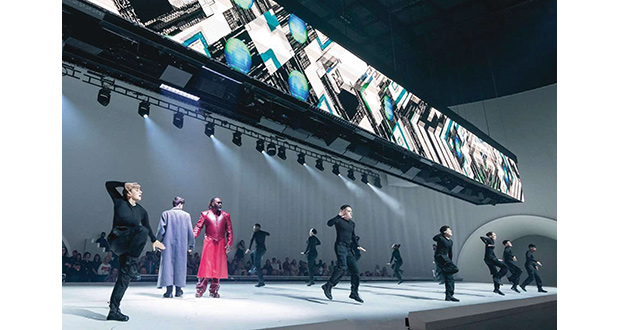Free Your Mind: The Matrix was an immersive, dance-based reimagining of the cult 90s movie franchise, created as the opening event for Manchester’s impressive new cultural space within Factory International. The brainchild of director Danny Boyle – who teamed up with choreographer Kenrick “H20” Sandy, composer Michael “Mikey J” Asante of Boy Blue, designer Es Devlin and writer Sabrina Mahfouz – the vision behind the production pulled some of the UK’s most creative talent into its orbit.
Sound design was by Gareth Fry, who specified TiMax SoundHub to handle the complex spatial audio requirements of The Warehouse where the event’s main action takes place.
The production moved from the smaller theatre space in Aviva Studios after the interval and significantly scaled up into the vast 21-metre-high Warehouse, with its aircraft hangar proportions. Set up in a traverse and promenade configuration, Fry explains, “In such a big space, with that audience-performer configuration, imaging is critical.”
Whilst the role of TiMax in the performance was to guide the eyes of the audience to the next point in the action, TiMax provided extensive support to deal with what Fry describes as “the complexities of positioning sound in space as well as the complex delaying of multiple speaker systems. Fry explains further that, “…the distances of the stage extremes in comparison with the slow speed of sound really interfere with each other, especially when you have high tempo rhythmic music.”
Playback for the show was handled by QLab which was fed into TiMax, along with the one handheld microphone used in the show. In turn, TiMax outputted to the multichannel distributed Warehouse speaker configuration comprised of a mixture of EM Acoustics loudspeakers and four Holoplot arrays. EM Acoustics EMR12s were rigged within the structure of the 38-metre-wide LED screen, firing down to provide great quality locational imaging on the stage area.
When the screen was flown up into the ceiling the Holoplot X1 arrays took over, using the speakers’ focused beams of sound to distribute musical stems from TiMax around the auditorium for a spatialised effect.
TiMax is a trusted tool for Fry who has relied upon its capabilities for many of his high-profile projects. He confirms, “I’ve used TiMax a lot on Harry Potter and the Cursed Child and it sounds great. Beyond that, the software is a lot more mature than its competitors, which makes it faster to set up and easier to use to achieve complex results.”
Fry adds, “Fortunately it is very quick to program and it took less than half an hour to delay the whole system and get it sounding good. Though not the reason for including TiMax in the specification, speed and ease of programming proved to be the aspect of using TiMax that I really came to appreciate, as construction delays began killing off a lot of our sound time.”
 AV Magazine AV Magazine
AV Magazine AV Magazine 





Have your say
or a new account to join the discussion.